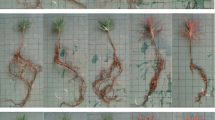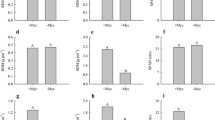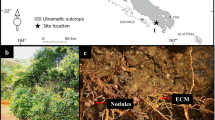Abstract
A pot experiment was conducted to study the effects of high concentrations of available Cu and Pb in soil originated from the vicinity of a copper foundry in Poland (Cu, 2,585–3,725 mg kg−1 d.wt.; Pb, 1,459–1,812 mg kg−1 d.wt.) on the growth and chemical constituents of Betula pendula seedlings. Control plants grew in unpolluted forest soil. Dry matter accumulation in the plants during the growing season and root/leaf mineral content were determined. Colonization of birch roots by ectomycorrhizal (ECM) fungi also was evaluated, as was soil dehydrogenase activity for influence of the metals on soil microorganisms. The heavy metals negatively affected seedling growth, ECM colonization, and soil dehydrogenase activity. A reverse relationship was found between ECM abundance and heavy metal concentrations in birch leaves, indicating the potential of mycorrhizas to protect the aboveground part of young silver birch seedlings from elevated environmental levels of Cu and Pb.





Similar content being viewed by others
References
Agerer, R. (Ed.) (1987–2002). Colour atlas of ectomycorrhizae, first to 12th ed., Schwäbisch Gmünd, Einhorn.
Bååth, E. (1989). Effects of heavy metals in soil on microbial processes and populations (a review). Water, Air, and Soil Pollution, 47, 335–379.
Bahlsberg-Pahlsson, A. M. (1989). Toxicity of heavy metals (Zn, Cu, Sd, Pb) to vascular plants. Water, Air and Soil Pollution, 47, 287–319.
Baker, A. J. M., & Brooks, R. R. (1989). Terrestrial higher plants which hyperaccumulate metallic elements—a review of their distribution, ecology and phytochemistry. Biorecovery, 1, 81–126.
Berthelsen, B. O., Olsen, R. A., & Steinnes, E. (1995). Ectomycorrhizal heavy metal accumulation as a contributing factor to heavy metal levels in organic surface soil. The Science of the Total Environment, 170, 141–149.
Blaudez, D., Botton, B., & Chalot, M. (2000). Effects of heavy metals on nitrogen uptake by Paxillus involutus and mycorrhizal birch seedlings. FEMS Microbiology Ecology, 33, 61–67.
Bojarczuk, K., Oleksyn, J., Kieliszewska-Rokicka, B., Zytkowiak, R., & Tjoelker, M. G. (2002). Effect of polluted soil and fertilisation on growth and physiology of silver birch (Betula pendula Roth.) seedlings. Polish Journal of Environmental Studies, 11, 483–492.
Bojarczuk, K., Oleksyn, J., Karolewski, P., & Zytkowiak, R. (2006). Response of silver birch (Betula pendula Roth.) seedlings to experimental variation in aluminum concentration. Polish Journal of Ecology, 54, 189–200.
Cairney, J. W. G., & Meharg, A. A. (1999). Influences of anthropogenic pollution on mycorrhizal fungal communities. Environmental Pollution, 106, 169–182.
Chaperon, S., & Sauvé, S. (2007). Toxicity interaction of metals (Ag, Cu, Hg, Zn) to urease and dehydrogenase activities in soils. Soil Biology and Biochemistry, 39, 2329–2338.
Cudlin, P., Kieliszewska-Rokicka, B., Rudawska, M., Grebenc, T., Alberton, O., Lehto, T., et al. (2007). Fine roots and ectomycorrhizas as indicators of environmental change. Plant Biosystems, 141(3), 406–425.
Denny, H. J., & Wilkins, D. A. (1987). Zinc tolerance in Betula species. I. Effect of external concentrations of zinc on growth and uptake. New Phytologist, 106, 517–524.
Derome, J., & Saarsalmi, A. (1999). The effect of liming and correction fertilisation on heavy metal and macronutrient concentrations in soil solution in heavy-metal polluted scots pine stands. Environmental Pollution, 104, 249–259.
Eltrop, L., Brown, G., Joachim, O., & Brinkmann, K. (1991). Lead tolerance of Betula and Salix in the mining area of Mechernich/Germany. Plant and Soil, 131, 275–285.
Ericksson, T., Rytter, L., & Vapaavuori, E. (1996). Physiology of carbon allocation in trees. Biomass and Bioenergy, 11, 115–127.
Fomina, M., Ritz, K., & Gadd, G. M. (2005). Negative fungal chemotropism to toxic metals. FEMS Microbiology Letters, 193, 207–211.
Forde, B., & Lorenzo, H. (2001). The nutritional control of root development. Plant and Soil, 232, 51–68.
Foy, S. D., Chaney, R. L., & White, M. C. (1978). The physiology of metal toxicity in plants. Annual Review of Plant Physiology, 29, 511–566.
Gadd, G. M. (1993). Interactions of fungi with toxic metals. New Phytologist, 124, 25–60.
Garcia, C., & Hernandez, T. (1997). Biological and biochemical indicators in derelict soils subject to erosion. Soil Biology and Biochemistry, 29, 171–177.
Godbold, D. L., Jentschke, G., Winter, S., & Marschner, P. (1998). Ectomycorrhizas and amelioration of metal stress in forest trees. Chemosphere, 36, 757–762.
Hartley, J. W., Cairney, G., & Meharg, A. A. (1997). Do ectomycorrhizal fungi exhibit adaptive tolerance to potentially toxic metals in the environment? Plant and Soil, 189, 303–319.
Högberg, M. N., & Högberg, P. (2002). Extramatrical ectomycorrhizal mycelium contributes one-third of microbial biomass and produces, together with associated roots, half the dissolved carbon in the forest soil. New Phytologist, 54, 791–795.
Holopainen, T., Heinonen-Tanski, H., & Halonen, A. (1996). Injuries to Scots pine mycorrhizas and chemical gradients in forest soil in the environment of a pulp mill in Central Finland. Water Air and Soil Pollution, 87, 111–130.
Hytönen, J., Saarsalmi, A., & Rossi, P. (1995). Biomass production and nutrient uptake of short-rotation plantations. Silva Fennica, 29, 17–39.
Ingleby, K., Mason, P.A., Last, F.T. & Fleming, L.V. (1990). Identification of ectomycorrhizas. ITE Research, De la Bastide and Kendrick Publication no.5. HMSO, London.
Jany, J. L., Garbaye, J., & Martin, F. (2002). Cenococcum geophilum populations show a high degree of genetic diversity in beech forests. New Phytologist, 54, 791–795.
Joner, E. J., & Leyval, C. (2003). Rhizosphere gradients of polycyclic aromatic hydrocarbon (PAH) dissipation in two industrial soils, and the impact of arbuscular mycorrhiza. Environmental Science and Technology, 37, 490–502.
Kabata-Pendias, A. (1995). Podstawy oceny chemicznego zanieczyszczenia gleb. Metale ciężkie, siarka i WWA. Warszawa: Biblioteka Monitoringu Środowiska, PIOŚ, IUNG.
Kabata-Pendias, A., & Pendias, H. (eds). (2001). Trace element in soils and plants (3rd ed.). Boca Raton: CRC.
Kashem, M. A., Singh, B. R., Kondo, T., Imamul Hug, S. M., & Kawai, S. (2007). Comparison of extractability of Cd, Cu, Pb and Zn with sequential extraction in contaminated and non-contaminated soils. International Journal of Environmental Science Technology, 4, 169–176.
Kieliszewska-Rokicka, B., Rudawska, M., Leski, T., & Kurczyńska, E. U. (1998). Effect of low pH and aluminium on growth of Pinus sylvestris L. seedlings mycorrhizal with Suillus luteus (L. ex Fr.) S.F. Gray. Chemosphere, 36, 751–756.
Kieliszewska-Rokicka, B., Rudawska, M., Staszewski, T., Kurczyńska, E., Karliński, L., & Kubiesa, P. (2004). Ectomycorrhizal associations in Norway spruce stands influenced by long lasting air pollution (Silesian Mountains, Poland). Ekologia, 23, 142–149.
Klink, A., Letachowicz, B., Krawczyk, J., & Wisłocka, M. (2006). The content of heavy metals in soil and silver birch leaves (Betula pendula Roth.) from Wałbrzych and Głogów. Polish Journal Environmental Studies, 15, 347–350.
Kloke, A. (1980). Orientierungsdaten für tolerierbare Gesamtgehalte einiger Elemente in Kulturboden. Mitteilungen des Verbandes deutscher landwirtschaftlicher Untersuchungs- und Forschungsanstalten, 1, 9–11.
Komosa, A., & Szewczuk, A. (2002). Effect of soil potassium level and different potassium fertilizer forms on nutritional status, growth and yield of apple trees in the first three years after planting. Journal of Fruit and Ornamental Plant Research, 10, 41–54.
Kopponen, P., Utriainen, M., Lukkari, K., Suntioinen, S., Karenlampi, L., & Karenlampi, S. (2001). Clonal differences in copper and zinc tolerance of birch in metal-supplemented soils. Environmental Pollution, 112, 89–97.
Leski, T., Rudawska, M., & Kieliszewska-Rokicka, B. (1995). Intraspecific aluminum response in Suillus luteus (L.) S.F. Gray., an ECM symbiont of Scots Pine. Acta Societatis Botanicorum Poloniae, 64, 97–105.
Lindsay, W. L., & Norvell, W. A. (1978). Development of DTPA soil test for zink, iron, manganese, and cooper. Soil Science Society America Journal, 42, 421–428.
Marguí, E., Queralt, I., Carvalho, M. L., & Hidalgo, M. (2007). Assessment of metal availability to vegetation (Betula pendula Roth) in Pb–Zn ore concentrate residues with different features. Environmental Pollution, 145, 179–184.
Meharg, A. A., & Cairney, J. W. G. (2000). Ectomycorrhizas—extending the capabilities of rhizosphere remediation? Soil Biology and Biochemistry, 32, 1475–1484.
Meyer, F. H. (1987). Extreme Standorte und Ektomykorrhiza (insbesondere Cenococcum geophilum). Angewandte Botanik, 61, 39–46.
Oleksyn, J., Zytkowiak, R., Reich, P. B., Tjoelker, M. G., & Karolewski, P. (2000). Ontogenic patterns of leaf CO2 exchange, morphology and chemistry in Betula pendula trees. Trees, 14, 271–281.
Page, B. D., & Mitchel, M. J. (2008). Influence of a calcium gradient on soil inorganic nitrogen in the Adirondack mountains, New York. Ecological Applications, 18, 1604–1614.
Pennanen, T., Frostegard, A., Fritze, H., & Bååth, E. (1996). Phospolipid fatty acid composition and heavy metal tolerance of soil microbial communities along two heavy metal-polluted gradients in coniferous forests. Applied and Environmental Microbiology, 62, 420–428.
Perez-Moreno, J., & Read, D. J. (2000). Mobilization and transfer of nutrients from litter to tree seedlings via vegetative mycelium of ectomycorrhizal plants. New Phytologist, 145, 301–309.
Perucci, P. (1992). Enzyme activity and microbial biomass in afield soil amended with municipal refuse. Biology and Fertility of Soils, 14, 54–60.
Prach, K., & Pyšek, P. (2001). Using spontaneous succession for restoration of human-disturbed habitats: Experience for central Europe. Ecological Engineering, 17, 55–62.
Pulford, I. D., & Dickinson, N. M. (2005). Phytoremediation technologies using trees. In M. N. V. Prasad, K. S. Sajwan & R. Naidu (Eds.), Trace elements in the environment (pp. 383–403). Boca Raton: Taylor and Francis.
Regvar, M., Vogel-Mikuš, K., Kugonič, N., Turk, B., & Baltič, F. (2006). Vegetational and mycorrhizal successions at a metal polluted site: Indications for the direction of phytostabilisation? Environmental Pollution, 144, 976–984.
Rossel, D., Tarradellas, J., Bitton, G., & Morel, J. L. (1997). Use of enzymes in ecotoxicology: A case for dehydrogenase and hydrolytic enzymes. In J. Tarradellas, G. Bitton & D. Rossel (Eds.), Soil ecotoxicology (1st ed., pp. 179–192). Boca Raton: CRC Lewis.
Rosselli, W., Keller, C., & Boschi, K. (2003). Phytoextraction capacity of trees growing on a metal contaminated soil. Plant and Soil, 256(265), 2003.
Rudawska, M., & Leski, T. (2005). Trace elements in fruiting bodies of ectomycorrhizal fungi growing in Scots pine (Pinus sylvestris L.) stands in Poland. Science of the Total Environment, 339, 103–115.
Ruotsalainen, A. L., Markkola, A. M., & Kozlov, M. V. (2009). Mycorrhizal colonization of mountain birch (Betula pubescens ssp. czerepanovii) along three environmental gradients: Does life in harsh environments alter plant–fungal relationships? Environmental Monitoring Assessment, 148, 215–232.
Saarsalmi, A. (1995). Nutrition of deciduous tree species grown in short rotation stands. Academic dissertation, University of Joensuu, Finland, 60 p
Simon, E. (1978). Heavy metals in soil, vegetation development and heavy metal tolerance in plant populations from metaliferous areas. New Phytologist, 81, 175–188.
Smith, S. E., & Read, D. J. (1997). Mycorrhizal symbiosis (2nd ed.). New York: Academic.
Susarla, S., Medina, V. F., & McCutcheon, S. C. (2002). Phytoremediation: An ecological solution to organic chemical contamination. Ecological Engineering, 18, 647–658.
Staudenrausch, S., Kaldorf, M., Renker, C., & Luis, P. (2005). Diversity of ectomycorrhizal community at a uranium mining heap. Biology and Fertility of Soils, 41, 439–446.
Szarek-Łukaszewska, G., & Grodzińska, K. (2007). Vegetation of a post-mining open pit (Zn/Pb ores): Three-year study of colonization. Polish Journal of Ecology, 55, 261–282.
Von Thalmann, A. (1968). Zur Bestimmung der Dehydrogenaseaktivitat im Boden mittels Triphenyltetrazoliumchlorid (TTC). Landwirtschaftliche Forschung, 21, 249.
Tickle, A., Fergusson, M., & Drucker, G. (1995). Acid rain and nature conservation in Europe. A preliminary study of protected areas at risk from acidification. Gland: WWF International. 96 p.
Trevors, J. T. (1984). Dehydrogenase activity in soil. A comparison between the INT and TTC assay. Soil Biology and Biochemistry, 16, 673–674.
Turnau, K., Mleczko, P., Blaudez, D., Chalot, M., & Botton, B. (2002). Heavy metal bounding properties of Pinus sylvestris mycorrhizas from industrial wastes. Acta Societatis Botanicorum Poloniae, 71, 253–261.
Tyler, G. (1978). Leaching rates of heavy metal ions in forest soil. Water Air Soil Pollution, 9, 137–148.
Van Tichelen, K. K., Colpaert, J. V., & Vangronsveld, J. (2001). Ectomycorrhizal protection of Pinus sylvestris against copper toxicity. New Phytologist, 150, 203–213.
Wilkinson, D. M., & Dickinson, N. M. (1995). Metal resistance in trees: The role of mycorrhizae. Oikos, 72, 298–300.
Acknowledgments
This work was financially supported by Ministry of Science and Higher Education (grant no. NN 309 29 65 34) and by Institute of Dendrology (statutory project).
Author information
Authors and Affiliations
Corresponding author
Rights and permissions
About this article
Cite this article
Bojarczuk, K., Kieliszewska-Rokicka, B. Effect of Ectomycorrhiza on Cu and Pb Accumulation in Leaves and Roots of Silver Birch (Betula pendula Roth.) Seedlings Grown in Metal-Contaminated Soil. Water Air Soil Pollut 207, 227–240 (2010). https://doi.org/10.1007/s11270-009-0131-8
Received:
Accepted:
Published:
Issue Date:
DOI: https://doi.org/10.1007/s11270-009-0131-8




